Effects of whole-body vibration on proxies of muscle strength in old adults: a systematic review and meta-analysis on the role of physical capacity level
- PMID: 26865876
- PMCID: PMC4748331
- DOI: 10.1186/s11556-015-0158-3
Effects of whole-body vibration on proxies of muscle strength in old adults: a systematic review and meta-analysis on the role of physical capacity level
Abstract
Background: Dynapenia (age-associated loss of muscle strength not caused by neurologic or muscular diseases) and functional limitations (e.g. climbing stairs, chair rising) are important problems in elderly persons. Whole body vibration, used as an adjunct to classical resistance training or even as a stand-alone alternative, might help to reduce these problems. Its value might be highest in elderly persons with very low function, where whole body vibration can be used as a skilling up training until more conventional exercise types are possible. This systematic review and meta-analysis summarized the current evidence for whole-body vibration interventions on isometric maximum voluntary contraction, dynamic strength, power, rate of force development and functional strength in elderly categorised in different subgroups based on function levels.
Methods: An extensive literature search was carried out in February 2014 and repeated in February 2015 at PubMed, Cochrane Central Register of Controlled Trials, Physiotherapy Evidence Database and CINAHL electronic databases. The International Clinical Trials Registry Platform from the World Health Organization was also searched. Randomized controlled trials measuring isometric maximum voluntary contraction, dynamic strength, power, rate of force development and functional strength in studies using WBV intervention in 65 years or older elderly individuals were included. The methodological quality of included studies was assessed using the Cochrane Collaboration's tool for assessing Risk of Bias. Studies were classified based on the level of physical capacitiy of the participants as "Go-Go", "Slow-Go" or "No-Go". Data were pooled using a random effects model.
Results: Thirty-eigth articles of moderate methodological quality were included. The vibration modes for sinusoidal vertical whole-body vibration was between 25 and 40 Hz, the amplitude varied from 2 to 4 mm. Sinusoidal side-alternating -whole-body vibration revealed frequencies from 2.5 to 35 Hz with amplitudes ranging from 0.05 to 12 mm. Stochastic resonance whole-body vibration used frequencies between 3 and 6 Hz. Effect sizes in Go-Go were moderate after vertical sinusoidal Whole-body vibration compared to non-training control groups for isometric maximum voluntary contraction with effect size 0.48 (95 % CI 0.33 to 0.63) and for Dynamic Strength with effect size 0.47 (95 % CI 0.06 to 0.88). Side-alternating sinusoidal whole body vibration showed moderate effect sizes with 0.69 (95 % CI 0.32 to 1.06) for isometric maximum voluntary contraction, 0.50 (95 % CI 0.07 to 0.92) for power, 0.40 (95 % CI 0.16 to 0.64) for Rate of Force Development and 0.42 (95 % CI 0.13 to 0.71) for Functional Strength compared to non-exercise control. The analysis for Slow-Go showed for stochastic resonance whole-body vibration and Functional Strength an effect size of 0.97 (95 % CI -0.07 to 2.00) compared to non-exercise control in one study. No-Go showed for stochastic resonance whole-body vibration a moderate effect size with 0.50 (95 % CI -0.32 to 1.33) for Functional Strength compared to non-exercise control.
Conclusions: Whole-body vibration shows beneficial effects, mainly in the No-Go group elderly compared to non-training control and conventional strength training groups. The results suggest that WBV can be used as a skilling-up exercise in participants not able to perform standard exercises. Further studies with the various types of WBV in various sub-populations of elderly persons are needed to determine the most effective vibration modes.
Registration number: CRD42013006489.
Keywords: Dynamic maximum voluntary contraction; Functional strength; Isometric maximum voluntary contraction; Power; Rate of force development; WBV.
Figures

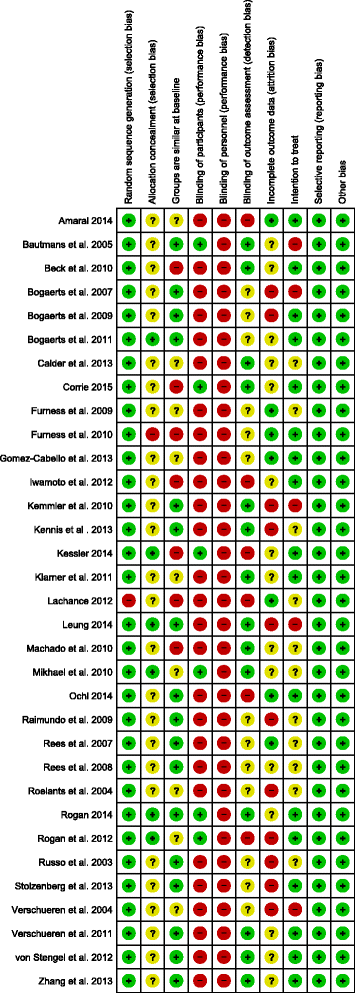
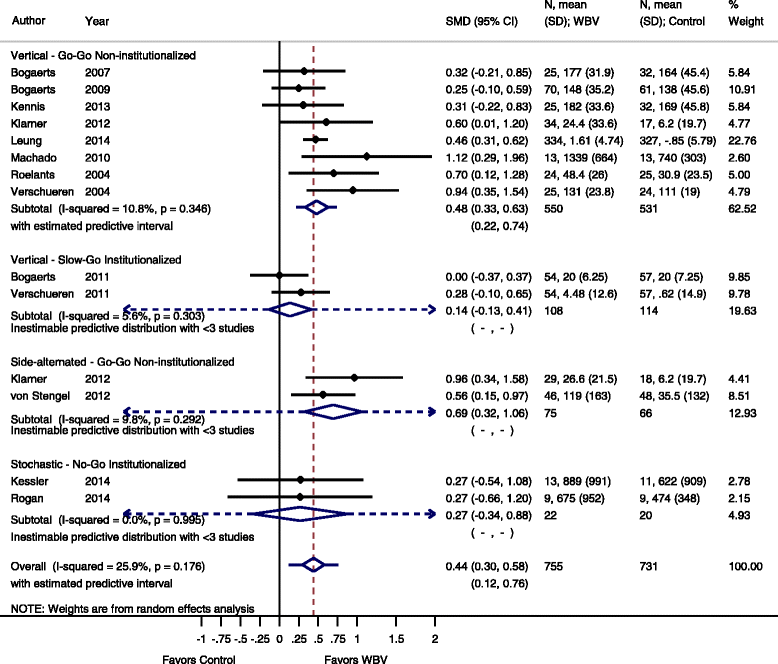

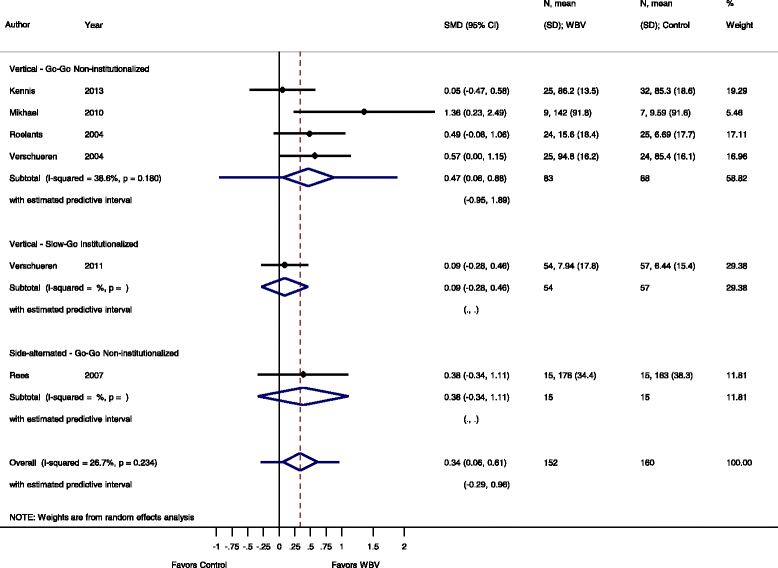
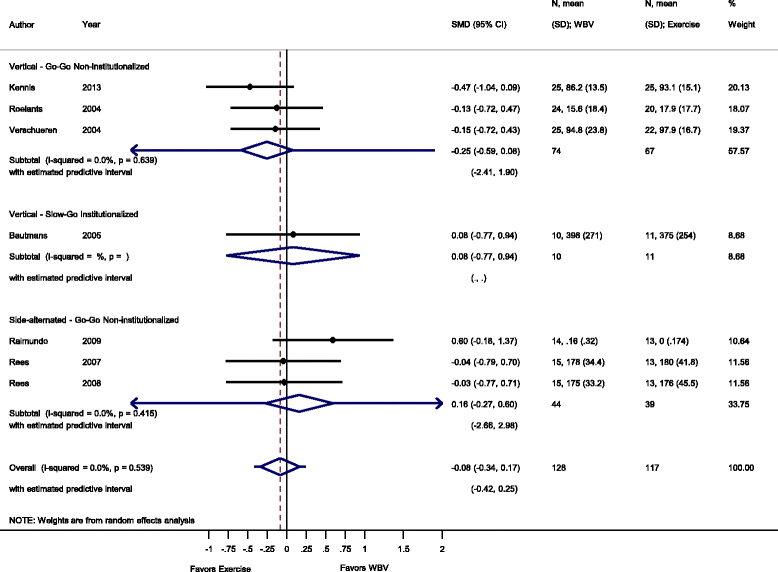
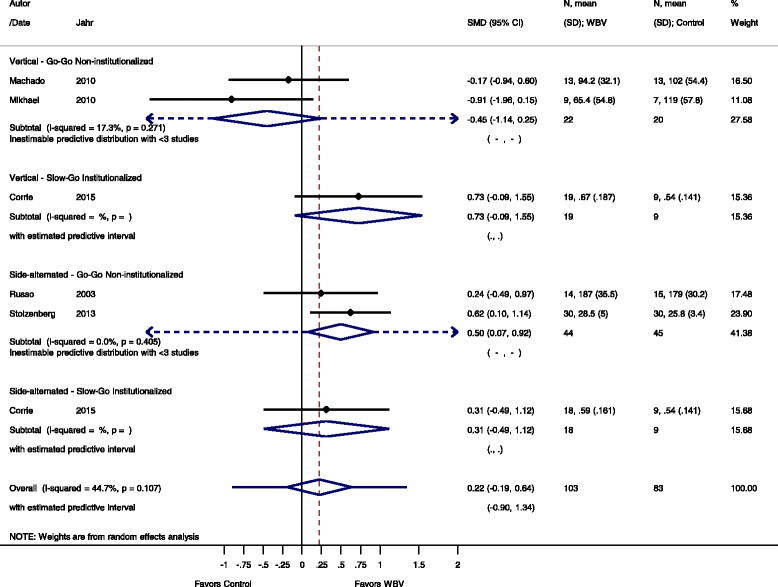
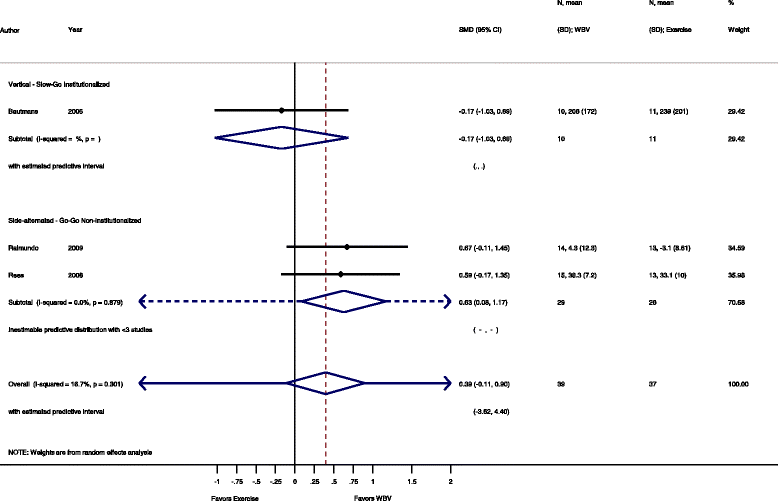

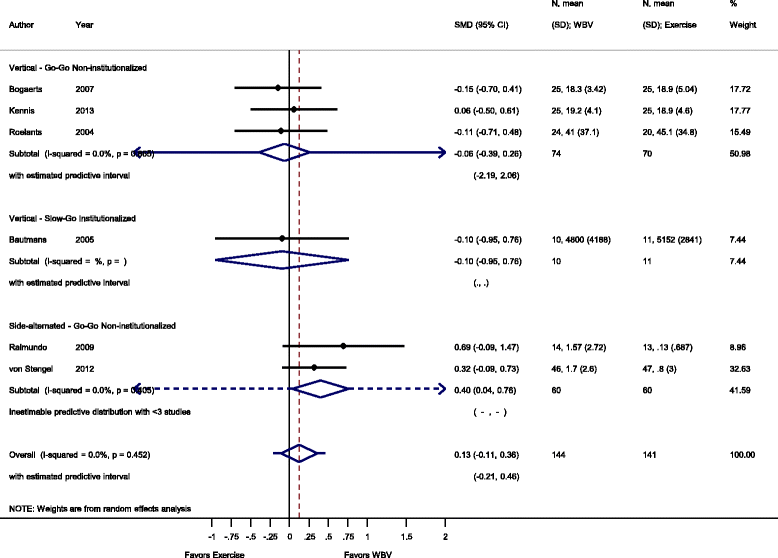



Similar articles
-
Immediate effects after stochastic resonance whole-body vibration on physical performance on frail elderly for skilling-up training: a blind cross-over randomised pilot study.Aging Clin Exp Res. 2014 Oct;26(5):519-27. doi: 10.1007/s40520-014-0212-4. Epub 2014 Apr 4. Aging Clin Exp Res. 2014. PMID: 24700493 Clinical Trial.
-
Long-Term Effects of Whole-Body Vibration on Human Gait: A Systematic Review and Meta-Analysis.Front Neurol. 2019 Jun 19;10:627. doi: 10.3389/fneur.2019.00627. eCollection 2019. Front Neurol. 2019. PMID: 31316447 Free PMC article.
-
Effects of Whole-Body Vibration Therapy on Knee Osteoarthritis: A Systematic Review and Meta-Analysis of Randomized Controlled Trials.J Rehabil Med. 2022 Mar 29;54:jrm00266. doi: 10.2340/jrm.v54.2032. J Rehabil Med. 2022. PMID: 35174868 Free PMC article.
-
Whole-body-vibration training increases knee-extension strength and speed of movement in older women.J Am Geriatr Soc. 2004 Jun;52(6):901-8. doi: 10.1111/j.1532-5415.2004.52256.x. J Am Geriatr Soc. 2004. PMID: 15161453 Clinical Trial.
-
Effects of a whole body vibration (WBV) exercise intervention for institutionalized older people: a randomized, multicentre, parallel, clinical trial.J Am Med Dir Assoc. 2015 Feb;16(2):125-31. doi: 10.1016/j.jamda.2014.07.018. Epub 2014 Oct 3. J Am Med Dir Assoc. 2015. PMID: 25282631 Clinical Trial.
Cited by
-
Effects of stochastic resonance whole-body vibration on sensorimotor function in elderly individuals-A systematic review.Front Sports Act Living. 2023 Apr 17;5:1083617. doi: 10.3389/fspor.2023.1083617. eCollection 2023. Front Sports Act Living. 2023. PMID: 37139302 Free PMC article. Review.
-
Postmenopausal Osteoporosis: The Role of Lifestyle in Maintaining Bone Mass and Reducing Fracture Risk.Am J Lifestyle Med. 2016 Dec 16;11(2):125-128. doi: 10.1177/1559827616682938. eCollection 2017 Mar-Apr. Am J Lifestyle Med. 2016. PMID: 30202323 Free PMC article.
-
Effects of vibration therapy on muscle mass, muscle strength and physical function in older adults with sarcopenia: a systematic review and meta-analysis.Eur Rev Aging Phys Act. 2020 Sep 17;17:14. doi: 10.1186/s11556-020-00247-5. eCollection 2020. Eur Rev Aging Phys Act. 2020. PMID: 32963629 Free PMC article. Review.
-
Resistance Exercise, Electrical Muscle Stimulation, and Whole-Body Vibration in Older Adults: Systematic Review and Meta-Analysis of Randomized Controlled Trials.J Clin Med. 2020 Sep 8;9(9):2902. doi: 10.3390/jcm9092902. J Clin Med. 2020. PMID: 32911822 Free PMC article. Review.
-
Effect of whole body vibration on HIF-2α expression in SD rats with early knee osteoarthritis.J Bone Miner Metab. 2020 Jul;38(4):491-500. doi: 10.1007/s00774-020-01092-3. Epub 2020 Mar 7. J Bone Miner Metab. 2020. PMID: 32146507
References
LinkOut - more resources
Full Text Sources
Other Literature Sources

